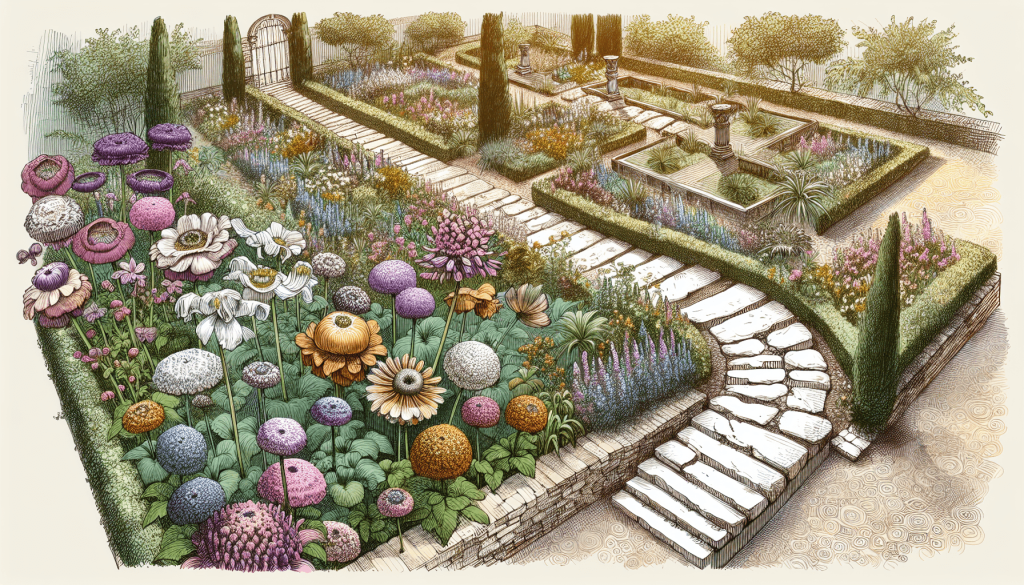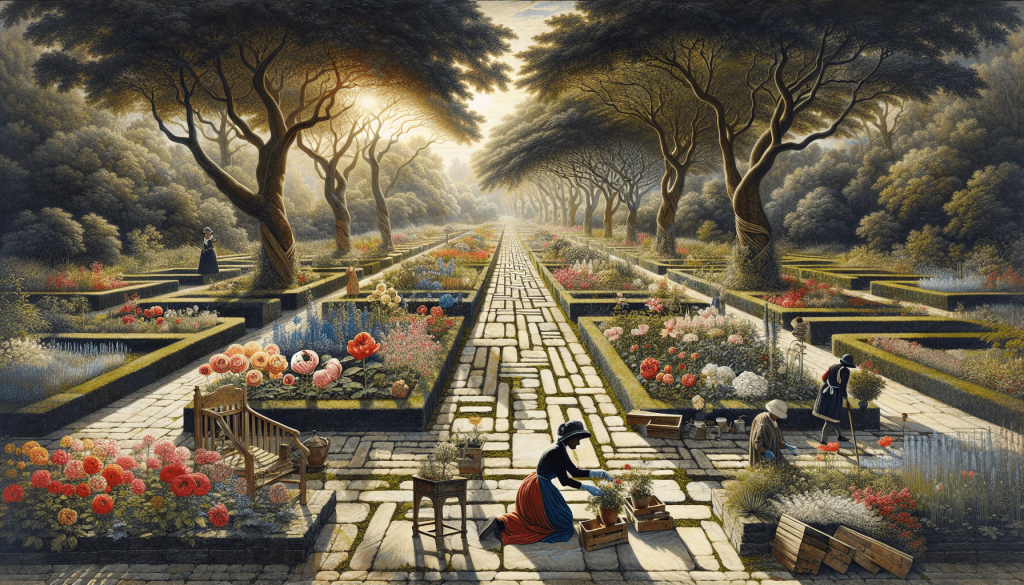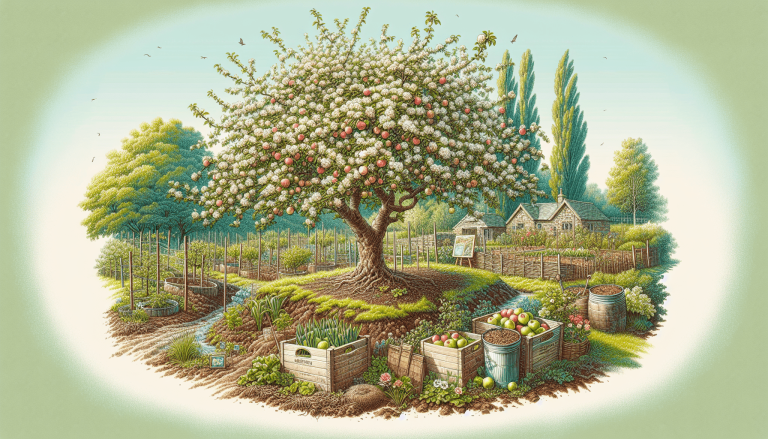Preserving the historical elements of a garden is not only a delightful endeavor but also a way to honor the rich heritage and stories embedded within the greenery. Whether you are a seasoned gardener or simply someone with an appreciation for history, there are a few tips that can help you maintain the authenticity and charm of a garden with historical significance. From researching the garden’s past to carefully choosing and maintaining period-appropriate plants, this article will provide you with valuable insights on how to preserve the historical elements of a garden. So grab your gardening gloves and get ready to embark on a journey through time as we explore the fascinating world of garden preservation.

Table of Contents
ToggleResearch the History of the Garden
Gather Information about the Garden’s Origins
To begin preserving the historical elements of a garden, it is essential to research its origins. Start by gathering as much information as possible about the garden’s history. Look for documents, records, or books that provide insights into the garden’s creation, development, and significant events. These sources can give valuable clues about the original layout, design, and purpose of the garden.
Consult Historical Records or Books on the Garden’s History
Once you have gathered basic information about the garden, dive deeper into its past by consulting historical records or books specifically dedicated to its history. These resources can provide invaluable details about the previous owners, the original purpose of the garden, and any notable events that took place within its grounds. Delving into the archives can uncover fascinating stories and anecdotes that add depth and character to the garden’s history.
Interview Previous Garden Owners or Gardeners
To gain a more personal and intimate understanding of the garden’s history, reach out to previous owners or gardeners who have a connection to the garden. These individuals can provide firsthand accounts, memories, and insights into the garden’s development over time. Interviews with them may reveal hidden secrets, specific techniques used, or valuable information that might not be found in public records or books. Their knowledge and experiences can bring the garden’s history to life and help guide preservation efforts.
Identify Significant Historical Elements
Determine the Age and Origin of Trees and Plants
As you seek to preserve the historical elements of the garden, it is important to identify the age and origin of the trees and plants within its grounds. Carefully analyze the species and varieties present in the garden to determine whether they are native or introduced. Research the historical landscaping practices of the time when the garden was created to understand the intentional selection and arrangement of plants. Identifying the age and origin of these botanical elements can provide valuable insights into the garden’s history and guide its preservation.
Identify Architectural Features and Structures
In addition to the flora, it is crucial to identify any architectural features and structures within the garden. These elements could include statues, fountains, pavilions, terraces, or pathways that contribute to the historical significance of the garden. Research the architectural styles prevalent during the garden’s era to understand the design principles employed. By recognizing and documenting these features, you can accurately restore and maintain them, ensuring they remain integral to the garden’s historical identity.
Recognize Historical Landscaping Techniques or Designs
To truly preserve the historical elements of a garden, it is vital to recognize and understand the historical landscaping techniques and designs that were employed when the garden was initially created. Research the prevailing gardening styles, such as formal, romantic, or naturalistic, and identify any specific design elements associated with them. Consider whether the garden followed any particular design principles, such as symmetry, focal points, or borrowed scenery. By recognizing and respecting these techniques, you can ensure the garden’s historical integrity is preserved.
Document and Record
Take Detailed Photographs of the Garden
To document the historical elements of the garden, take detailed and high-quality photographs that capture the essence of the space. Photograph the garden from various angles, capturing both wide shots and close-ups of significant features. Ensure the photographs include the landscaping, architectural structures, and any distinctive elements that showcase the garden’s history. These images will serve as a visual record for future reference and a valuable tool for restoration and educational purposes.
Create a Garden Inventory
To keep track of the garden’s historical elements, create a comprehensive inventory that lists all significant trees, plants, architectural features, and structures. Include details such as species, age, size, and condition. This inventory serves as a valuable reference for ongoing preservation efforts, as it allows you to identify any changes or damages that may occur over time. Updating the inventory regularly ensures the historical elements are properly tracked and managed.
Record Historical Information and Stories
Recording the historical information and stories associated with the garden ensures that the garden’s rich past is preserved alongside its physical elements. Collect anecdotes, interviews, and accounts from previous owners, gardeners, or local historians who may have knowledge about the garden’s history. Documenting these stories in written or audio formats ensures that the garden’s narrative is preserved for future generations. This historical context adds depth and significance to the garden, making it a living testament to the past.
Implement Conservation Methods
Maintain the Health and Condition of Trees and Plants
Preserving the historical elements of a garden requires diligent care and maintenance of its trees and plants. Regularly inspect the garden for any signs of disease, stress, or damage, and take prompt action. Consult with arborists or horticulturists if necessary to ensure proper pruning, fertilization, and pest control techniques are employed. By maintaining the health and condition of the garden’s botanical elements, you can help extend their lifespan and sustain the historical integrity of the garden.
Repair and Restore Architectural Features
Architectural features and structures within the garden may require periodic repair and restoration to retain their historical value. Inspect these elements regularly for signs of wear, damage, or decay. Seek advice from preservation experts or specialists in historical architecture to ensure proper restoration techniques are employed. By restoring these features to their original condition or maintaining their historical appearance, you contribute to the overall preservation of the garden’s integrity and charm.
Preserve the Original Layout and Design
To preserve the historical elements of a garden, it is crucial to respect and maintain the original layout and design as much as possible. Research the original plans, if available, and consult historical photographs or records to understand the intended arrangement of the garden’s features. Avoid making drastic changes or introducing modern elements that may compromise the historical integrity of the space. By preserving the garden’s original layout and design, you allow visitors to step back in time and appreciate its historical significance.
Practice Sustainable Gardening
Use Native Plants and Species
Incorporating native plants and species into the garden not only enhances its ecological value but also aligns with sustainable gardening practices. Native plants are adapted to the local climate and require less water, fertilizer, and pesticides than exotic species. By utilizing native plants, you promote biodiversity and create a garden that is environmentally resilient. Additionally, reintroducing historically significant native plants can help restore the garden’s original flora and add an authentic touch to its historical elements.
Implement Organic Fertilizers and Pest Control Methods
To maintain the garden’s historical integrity, it is advisable to implement organic fertilizers and pest control methods. Avoid using synthetic chemicals that may harm the environment or disrupt the delicate ecosystem of the garden. Instead, opt for natural and organic fertilizers, compost, and insect control techniques. This approach not only promotes sustainability but also ensures the long-term health and vitality of the garden’s historical elements.
Conserve Water and Promote Biodiversity
Water conservation is a crucial aspect of sustainable gardening and plays a vital role in preserving the historical elements of a garden. Implement water-efficient practices such as drip irrigation, mulching, and proper watering schedules to minimize water waste. Additionally, promote biodiversity by creating habitats for local wildlife, including birds, butterflies, and beneficial insects. Native plants and a well-designed garden layout can contribute to biodiversity, creating a balanced ecosystem that supports the garden’s historical elements.
Monitor and Control Invasive Species
Identify and Remove Invasive Plants
Invasive plants can threaten the historical elements of a garden by outcompeting or overtaking native species. Regularly monitor the garden for the presence of invasive plants and quickly identify and remove them. Consult with experts or local nurseries to help identify invasive species in your region. Vigilance and prompt action are crucial in preventing the spread of these plants, as they can disrupt the garden’s historical ecosystem and jeopardize the health of native flora.
Implement Barriers or Boundaries to Prevent Spread
To prevent the spread of invasive species, implement physical barriers or boundaries that limit their encroachment into the garden. Depending on the specific invasive plant, this may involve installing underground barriers, constructing fences, or using edging materials. These measures help contain invasive species and protect the historical elements of the garden from their detrimental effects. Regularly inspect and maintain these barriers to ensure their effectiveness.
Regularly Monitor and Maintain the Garden for Invasives
Monitoring the garden for invasive species should be an ongoing effort. Regularly inspect the garden and familiarize yourself with the early signs of invasive plant infestations. Act promptly to remove any newly identified invasives before they can establish themselves. Regular maintenance practices such as weeding, mulching, and proper disposal of plant waste can help prevent the introduction and spread of invasive species. By staying vigilant and proactively managing invasives, you can protect the historical elements of the garden and maintain its ecological balance.
Engage with Experts and Preservation Organizations
Seek Advice from Botanists, Arborists, or Horticulturists
When preserving the historical elements of a garden, seeking advice and guidance from experts in the field can be invaluable. Consult with botanists, arborists, or horticulturists who specialize in historical gardening. These professionals can provide insights and recommendations on specific preservation techniques, plant care, and restoration strategies. Their expertise ensures that the historical elements are properly preserved and managed, enhancing the garden’s overall authenticity and value.
Collaborate with Historical and Preservation Societies
Collaborating with historical and preservation societies can provide access to a wealth of knowledge and resources specific to garden preservation. These organizations are often dedicated to preserving historical sites and landscapes and can offer guidance, funding opportunities, and networking opportunities. By working together, you can leverage their expertise and collective efforts to ensure the long-term preservation and appreciation of the garden’s historical elements.
Attend Workshops or Seminars on Garden Preservation
Continued education and learning are crucial when it comes to preserving the historical elements of a garden. Attend workshops, seminars, or conferences dedicated to garden preservation and historical landscape management. These events offer opportunities to learn from experts, gain insights into new preservation techniques, and connect with like-minded individuals who share a passion for historical gardening. By staying informed and engaged, you can continuously improve your preservation practices and contribute to the broader efforts within the field.
Educate and Share the Garden’s History
Create Interpretive Signs or Plaques
To share the garden’s history with visitors, create interpretive signs or plaques that provide relevant information about its historical elements. Place these signs strategically throughout the garden, near key features or structures, and include concise descriptions or stories that capture the essence of its history. Use engaging language and captivating visuals to make the information accessible and interesting to a wide range of visitors. These signs can serve as educational tools and help cultivate an appreciation for the garden’s historical significance.
Organize Guided Tours or Open Days
To further engage visitors and offer a more immersive experience, organize guided tours or open days that focus on the garden’s historical elements. Trained guides can lead visitors through the garden, sharing stories, anecdotes, and interesting facts along the way. Allow visitors to explore specific areas or structures that highlight the historical elements, creating a memorable and educational experience. Guided tours and open days provide an opportunity to foster a connection between visitors and the garden’s history, increasing awareness and appreciation.
Share the Garden’s Story through Social Media or Websites
In the digital age, social media and websites offer powerful platforms to share the garden’s story with a wider audience. Create a dedicated website or social media accounts that showcase the historical elements, document preservation efforts, and share interesting facts or stories. Use captivating visuals, engaging narratives, and educational content to attract followers and create a community around the garden’s history. These platforms can serve as virtual extensions of the garden, reaching individuals who may not have the opportunity to visit in person and increasing awareness and support for preservation efforts.
Encourage Community Involvement and Support
Organize Volunteer Days for Garden Maintenance
Preserving the historical elements of a garden is a collective effort that can be enhanced through community involvement. Organize volunteer days or gardening events where individuals from the community can contribute to the maintenance and preservation of the garden. Provide training and guidance on specific tasks, such as weeding, pruning, or restoration projects. By involving the community, you build a sense of ownership and foster a shared responsibility for the garden’s historical elements.
Invite Local Schools or Organizations for Educational Activities
Engaging local schools or organizations in educational activities centered around the garden’s history is an effective way to raise awareness and foster a love for historical preservation. Invite students for field trips or organize workshops that educate participants about the garden’s historical elements, sustainable gardening practices, or the importance of preserving cultural heritage. By instilling a sense of appreciation and understanding in the younger generation, you ensure the garden’s preservation efforts continue into the future.
Seek Sponsorships or Grants for Restoration Projects
Preserving the historical elements of a garden often requires financial resources. Seek sponsorships or apply for grants specifically designed to support restoration projects or historical preservation. Local businesses, philanthropic organizations, or government agencies may be interested in contributing to the preservation of cultural heritage within the community. By securing financial support, you can undertake restoration projects, acquire necessary tools or equipment, and ensure the long-term preservation and sustainability of the garden’s historical elements.
Plan for the Future
Develop a Long-Term Preservation and Maintenance Plan
Preserving the historical elements of a garden requires a long-term vision and planning. Develop a comprehensive preservation and maintenance plan that outlines specific goals, strategies, and timelines for ongoing care. Consider factors such as regular maintenance tasks, restoration projects, budget allocation, and succession planning. Regularly review and update the plan to adapt to changing circumstances and ensure the continuity of preservation efforts.
Consider Succession Planning for Future Guardians
To ensure the garden’s historical elements are preserved for generations to come, consider succession planning for future guardianship. Identify individuals, organizations, or institutions that can take on the responsibility of caring for and preserving the garden’s historical elements in the future. Establish partnerships or agreements that outline the expectations and commitments involved in transitioning guardianship. By planning for succession, you ensure that the historical integrity of the garden is upheld even as ownership or management changes.
Explore Funding Options for Ongoing Conservation Efforts
Sustaining the preservation of the garden’s historical elements requires ongoing financial support. Explore various funding options, such as endowments, grants, sponsorships, or fundraising initiatives, to secure resources for the long-term conservation efforts. Collaborate with preservation organizations, engage with local stakeholders, and develop innovative approaches to generate financial support. By exploring diverse funding options, you can ensure the ongoing care and preservation of the garden’s historical elements.
In conclusion, preserving the historical elements of a garden requires a comprehensive approach that encompasses research, documentation, conservation, education, and community involvement. By gathering information about the garden’s origins, identifying significant historical elements, and implementing conservation methods, the garden’s historical integrity can be protected. Engaging with experts, sharing the garden’s history, and encouraging community involvement generate awareness and support for preservation efforts. With careful planning for the future and a commitment to sustainable gardening practices, the historical elements of a garden can continue to inspire and enrich the lives of future generations.







